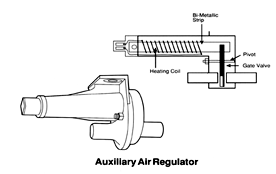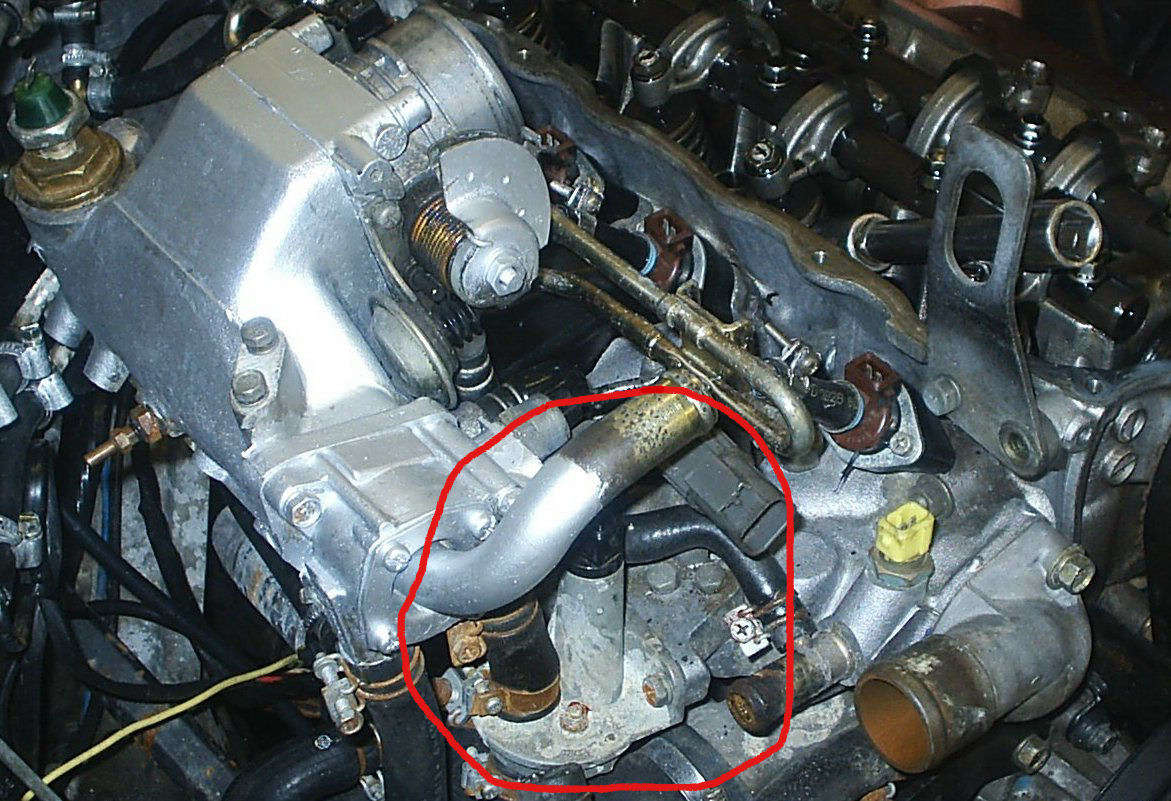|
|
 |
Most of this information I have gleaned from various other sites on the internet, and tried to remove the references to FWD installations where possible! This is by no means an exhaustive "how to" guide, but gives you an insight into a few of the things to note.
The CVH engine used in most SS1s (and SSTs and possibly a few MK1 Sabres for that matter) isn't a bad engine, just that the 1300, 1400 and 1600 engines don't exactly have the power capacity of Nissans CA18ET engine in the 1800Ti. If you want to enjoy your SS1 more, then its either sell it and buy an 1800Ti, or look for more power from Fords CVH. Conventional tuning mods still exist and work well (twin Weber carbs, turbo charging, conventional head and cam mods - see Hot Hatch Hunting), but why not go for the CVH's successor - the Zetec.
Given the effort required to fit a Zetec (actually not a great deal in engine swap terms!), I'd suggest going for either the 130PS 1.8 or the 2.0. Both units actually share the same head, cams, throttle body and ECU, as well as both having under piston oil cooling jets (absent on the lower 1.8's and 1.6's - the drillings are there, but the jets aren't).
A few notes about where to get them from:
Fiesta Mk3-on - The XR2i 16V had the 1.8 105PS; the RS1800 had the 130PS unit.
Escort XR3i Mk5 - came in both 105 and 130PS versions, but the cabriolet only came with the 130PS engine.
Orion - short lived by the time for the Zetec arrived; only the Ghia Si was available with the 130PS; others are 105PS.
Mondeo - The 1.8 was quoted at 115PS (as were later Escort Si and GTi models), and is a tweaked 105 unit. The 2.0 is quoted at 134-ish PS; doesn't sound a lot but the inlet manifold was biased towards low down torque as opposed to top end power.
There are 3 "versions" of the Zetec, generally quoted as Phase 1, 2 and 3
| Phase 1 | Phase 2 | Phase 3 | |
| Cam Shaft Cover | Aluminium | Early: Black Coated Magnesium Later: Plastic |
|
| Label | DOHC 16v | 16v Zetec | 16v Zetec |
| Sump | Single Part Aluminium | Two Part Aluminim / Tin | |
| Water Pump | Directly Above Crank | Offset to Exhaust Side of Crank | |
| Oil Filter | Angled Downwards | Horizontal | |
| Cam Belt Cover | Plastic | Plastic / Aluminium | |
| Followers | Hydraulic | Solid | |
Series 3 engines are also known as the "Focus" Zetec, as it came out with the Ford Focus, and also replaced the (now) Phase 2 unit in the Mondeo at the time (1998).
Firstly, you have 2 choices; do you stick with injection, or put a pair of Webers on it?
Carburettors
There are a number of propriety manifolds and kits available from your local Ford tuner to drop a pair of Italy's finest petrol pumps on. With the fuel sorted, how do get round the sparks side? The Zetec doesn't have a distributor, just a single crank sensor using the 36-1 tooth method of encoding (36 teeth spread around the back of the flywheel, but with one missing at the datum point), and a crank sensor (only used for sequential injection). You can either go to an ECU supplier to provide a ignition only ECU for a few hundred quid to use the existing pickup and coil pack, or to get 95% there, you can use the igntion system from a late CVH Mk4 Carburettored 1.6 Escort. This is a complete standalone ignition system with a sufficient ignition map to run the engine quite well using the ESC system, and uses the standard Zetec pickup and coil pack. Pick up sufficient wiring from the donor car, and you'll be left with 3 wires; 12V, ground and a feed to the tacho!
Here the options start flying... Do you keep the existing hardware and electronics, or go for an alternative for either?
First off; the electronics side:
| Ford EEC-IV (Standard) | Aftermarket |
| Works out of the box | Allows you to learn how injection works |
| Cannot change any values yourself | Can be mapped by anyone with a laptop (usually) |
| Known quantity | Allows you to substitute different hardware (injectors, throttle bodies, etc) |
| May have the inbuilt immobiliser - will need bypassing/integrating before use. | Some ECUs can have switchable maps for road and race |
| Allows diagnosis by any Ford dealer | Allows any engine mods (cams, turbo, nitrous!) |
| You put it together, you can fix it! |
As soon as you make a mod of pretty much any type, aftermarket wins as soon as you pay for your first "chip".
Hardware wise, the quick version is to use the existing Ford hardware, but even here there are choices! The early Escort/Fiesta Phase 1 Zetecs used an "over the top" inlet manifold (as per the CVH EFi), but Mondeos and later Zetecs generally had a low down, vertical throttle body. The vertical one might cause installation problems in an SS1 due to the proximity of the steering column and chassis rails, although i've not yet confirmed this It does make rear wheel drive installation easier, however. The over the top manifold also gets very close to the bonnet (and may hit it - not sure still), but there are a few alternative manifolds primarily for RWD installations from YKC Sportscars, Fisher (makers of the Sylvia Fura) plus others. I like using (and modifying) standard parts, so i'm currently looking at using a Rover T-series inlet manifold (yep..that's right). There is even an adaptor plate available off the shelf from Ferriday Engineering to mate the two! The only problem so far is the manifold points to the back of the engine..one chop and re-weld coming up!
There are other advantages to using the Rover manifold; the Zetec uses side-feed injectors as opposed to the usual end-feed units on the Rover. Side feed ones aren't available is such a wide range and if your other mods mean you're running out of injector capacity, then the next size up is quite a jump and will make mapping a bit tricky. Ford Galaxy/Scorpio 2.3 ones apparently fit if you're staying with normal (i.e. non-turbo) induction. The position of the idle speed valve also prevents the fitment of top-feed injectors which means moving it (not easy, but possible). Some CVH EFI manifolds have a hose-fitting ICSV valve, so this could be used - but if you're not using the Ford ECU, then there is a much easier way; use the Bosch fast thermostatic idle valve from any 80's injection car:

It's actually the same one as used on the 1800Ti...

This does involve removing the old ICSV and making take-offs for the air pipes...
If converting your standard CVH SS1 to injection, there are a few other matters to consider; the addition of an inertia switch is a good idea, plus you'll need a high pressure injection pump. If you just mount one, then there's a risk of running out of fuel on corners as the pump won't suck air - plus the engine won't run well on it either. The best setup would be a low pressure pump mounted on the rear chassis rail (like a Facet red-top) feeding a swirl pot; this in turn feeds a high pressure injection pump. External pumps (as opposed to modern in-tank pumps) are found on virtually all injection engines of 80's and early 90's vintage, normally found under the back of the car by the fuel tank, or buy a new one from any good supplier (about £60 and upwards). It is this setup i've got installed in mine using a Facet Red-top competition pump feeding a pot around 0.7l in capacity, in turn feeding the pump from a 728i BMW.
The water pump inlet, however, is considerably larger that the CVH one which calls for a reducer, or use a Zetec bottom hose which splits the pipe to the heater hose, then reduces to the normal CVH pipe dimension.
Oil filter and Pump
Here we have a little problem (or is it..). The Zetec oil filter is no longer mounted on the block, like the CVH, but attached to the oil pump itself at the front of the engine. Looking at the 2 versions of pump/filter mounting available (Escort and Mondeo), the Mondeo version will allow a remote oil filter to be used, whereas the Escort version will try and put the oil filter in the way of an SS1 engine mounting.
Engine Mountings
The SS1 CVH mountings will meet up with the Zetec block well, although a little "tickling" will be needed.
Exhaust
You have a few choices..Use one of the standard exhaust manifolds and make up a new downpipe to get the gasses out (but remove the EGR pipework and plug the holes in the manifold), or get a lovely tubular one like Paul Hunt. There are different ones out there; some in single pipe and other in twin pipe guise. Personally i'd go for the single version as it makes downpipe fabrication much easier. If going for a turbo (!) you can either get a tubular one made, try and find one from a Focus RS, although apparently one from an early Focus has the right exhaust flange to fit a Garret T3.. (Update: I've now located a Focus 2.0 one and the flange looks right for a 3-bolt Garret T2/T25 mounting, but as it is tubular stainless steel a new flange can be welded on to fit any turbo you like. I'm hoping to use a standard Sierra Cosworth T3 unit.)
Clutch and Gearbox
The std CVH gearbox will mate with the Zetec block, although there will be changes to the flywheel and clutch. The Zetec flywheel has larger holes for the crank bolts (11mm vs 10mm) than the CVH flywheel, plus you'll need the Zetec flywheel as it has the timing marks for the crank sensor built into the back of it! The 1.6/1.8 Zetec flywheel uses a standard Ford 220mm clutch and is also considerably lighter than the 2.0 one. This allows the usage of a standard or uprated RS Turbo clutch (if needed - the standard Zetec one can also be used). There are a couple of other things to note: The clutch release bearing needs swapping for one from a 1982-89 Ford Sierra 2.0 OHC (Quinton Hazell part CCT132) if using the 1.8 flywheel and clutch, the 2.0 Zetec one needs a standard 2.0 clutch and a clutch release bearing from a 1971-88 Ford Transit 2.4/2.5 diesel (Quinton Hazell part CCT303). You will also need the spigot bearing for the first motion shaft to run in; It comes from the 1.8 Sierra. The Ford part number is FINIS code 1554973, apparently.
The stock starter motor will no longer engage with the ring teeth, so either space it back (forwards!) from the bellhousing with some spacers, or you will need a starter motor from a Ford Sierra with a 1.8 CVH or 2.0 DOHC engine. The Lucas part for this is the LRS707.
Futher info here...
![]()